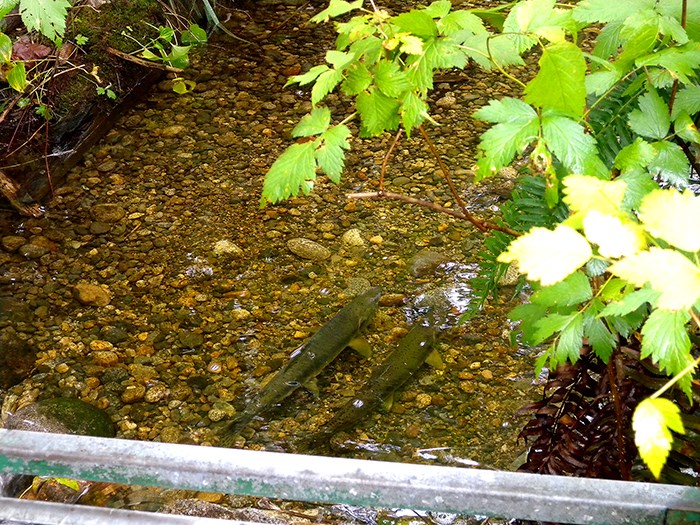The autumn is always an exciting time when adult salmon return to spawn in local creeks. Until they appear, we have little sense of how many salmon have survived perilous journeys to the ocean and are able to return to the stream of their birth to spawn.
This year, local salmon stewards in Port Moody were delightfully surprised when mature pink salmon appeared in large numbers in both Mossom and Noons creeks. While there had been anecdotal reports of their historical presence in both creeks, none had been seen in recent years, with the exception of four adults in Mossom two years ago.
Nature, it seems, always has a few wonderful surprises up her sleeve.
Pink salmon, the most abundant but smallest of our Pacific salmon species, are commonly called “humpies” because of the exaggerated hump that develops along the back of spawning males. Pink salmon runs are scare south of Puget Sound but are present in B.C., Alaska, Japan, Korea and the Kamchatka Peninsula in Russia.
All pinks migrate to the ocean before returning to spawn in fresh water and die at two years of age — in fact, they are unique among salmon for their strict and quick two-year period to reach maturity.
In B.C., the largest run of pink salmon is in the Fraser River. There, the pinks return in large numbers in odd years (e.g., 2013, 2015) while even years have no pink salmon returns. Why this is the case has always been a mystery to fish biologists, who tend to view this “on-off” cycle as a waste of good fish habitat. On the west coast of Vancouver Island, pink salmon spawn every year but, there, the predominant runs are in even years. In Alaska, even-year populations are larger, which could suggest a pattern of even-year pinks preferring colder waters.
Like chum salmon, pinks tend to spawn in the lower reaches of streams and rivers. Also similar to chum, once their eggs hatch, the fry quickly make their way downstream to salt water. Thus, both these species have evolved to take advantage of streams that have low or no flows during the dry summer months. But unlike chum, pink salmon tend to return early in the season, which presents them with the additional challenge of finding streams with sufficient water for spawning. They often return to spawn in late August, when local streams still await the replenishing rains. This may be the reason pinks also have the reputation for “straying” from their natal streams. This trait confers good survival characteristics upon them as it increases their ability to take advantage of suitable habitat wherever they can find it.
In the early years of rearing fish in hatcheries, biologists were far more inclined to try to improve upon nature than they are now. Despite several efforts to establish pink runs every year in Puget Sound as well as Robertson Creek, the Bear River and Big Qualicum River in B.C., all such attempts were spectacularly unsuccessful.
There is, however, one strange exception to all these attempts.
Back in the 1950s, when fish biologists were unwisely prone to introduce salmon to rivers where they had never been, an attempt was made to introduce pink salmon from B.C.’s Lakelse River to Goose Creek, a stream in Ontario that flows into Hudson Bay. While this attempt failed, 21,000 surplus fry were dumped down a drain from a hatchery in Port Arthur at the head of Lake Superior. Some of these discarded fish must have survived as pink salmon were found spawning in Minnesota in 1957. By 1979, pink salmon were found in all the Great Lakes.
This was the first known example of pink salmon being able to complete their life cycle entirely in fresh water. Even more surprising was that the apparently fixed two-year cycle of these pink salmon had changed. It appears that pink in the Great Lakes now mature at one, two or three years of age. Exactly why this happened remains a mystery. Nonetheless, it is a good example of unintended consequences. Today, biologists would never introduce fish species into systems where they have never been found.
Volunteers at hatcheries in Port Moody were thrilled to have pink salmon appear in September as the restoration of pinks to these streams had been discussed as a possible project for several years. We speculate these pink were essentially overflow from a very successful project undertaken by the Tseil-Waututh First Nation at the head of Indian Arm to improve pink spawning habitat. This August, more than two million pink salmon arrived in the Indian River to spawn. Some of these were likely not able to find unoccupied spawning habitat and sought out other suitable areas nearby.
The return of pink salmon is also good news for South Schoolhouse Creek in Coquitlam. This creek, which flows out of Miller Ravine in the Chines area, has been identified as a habitat compensation project for the Evergreen SkyTrain line. Next summer, the lower part of South Schoolhouse will be the focus of a major project to remove large concrete slabs from the stream bed and restore spawning habitat areas specifically designed for pink salmon. If nature is on our side, the timing will be perfect for what we hope will be a successful return of pink salmon to Port Moody arm in 2017.
Elaine Golds is a Port Moody environmentalist who is conservation/education chair of the Burke Mountain Naturalists and member of the boards of the Colony Farm Park Association and the Port Moody Ecological Society.



